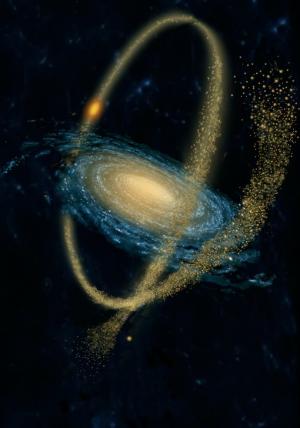A study notes that the population of younger globular clusters within the Milky Way tend to lie in a plane tilted somewhat with respect to the Galaxy’s polar axis. Furthermore, also contained in this plane tend to be most of the known satellite galaxies. A similar structure is noted for M31, the Andromeda galaxy.
Rather than the conclusion that this must hint at a past galactic merger, should not this observation lend support for the SQK model’s notion that the young globulars are progenitors of the satellite galaxies; that the globulars have been ejected from the Milky Way core and eventually grow into the dwarf satellite galaxies?
Can SQK shed any light on why there is a preferred plane in which these globulars and satellites are found?
http://www.physorg.com/news/2011-09-globular-clusters-plane.html
——————————-
In response to your comment, yes, I agree that this recent discovery of there being a preferred plane for both Milky Way satellite galaxies and massive-star globular clusters does point to the subquantum kinetics continuous creation scenario. It indicates that both likely originated through explosive ejection from our galaxy’s core and did not accrete to this plane from outside our galaxy.
Think about it for a minute. If these galaxies and globular clusters had entered our galaxy’s environs from outside as a result of gravitational attraction, they should have entered in random directions and hence should not be aligned in any kind of plane. To explain a planar alignment with the outside origin theory, astronomers are left to hypothesize the existence of a large concentration of dark matter being embedded in this plane as a ring of dark matter filaments to preferentially draw these masses into this planar alignment and maintain them there. In fact, this is just what Keller et al. suggest in their paper to explain this planar alignment phenomenon which they have discovered. But there is no independent evidence for such dark matter. In actual fact it is a fudge factor that astronomers arbitrarily introduce to explain the unexpected existence of the planar alignment they have found.
A much simpler explanation, one that does not need any ad hoc dark matter assumption, is that these globular clusters and dwarf galaxies were ejected from the center of the Galaxy during periods when the core engages in Seyfert-like activity. The smoking gun is the discovery that hypervelocity stars and high velocity gas clouds are receding from the galactic center at high angles to the galactic plane. In fact, the plane of the high-mass globulars and dwarf galaxies is found to be oriented almost perpendicular to the galactic plane, being inclined just 8 ± 5 degrees from the Milky Way’s pole axis direction. Take as an example the hypervelocity star HE_0437-5439, which is found to be receding from the Galactic center at 700 km/s and currently is seen at galactic coordinate position (l = 263.0°, b = -40.9°). Its coordinate location happens to deviate by just 10° from this globular cluster plane. Is this just a coincidence? I think not. This leads us to believe that there is a preferred direction in which our galactic core ejects stars and globular clusters with enough force to take them to these high latitude positions.
In the subquantum kinetics cosmology, dwarf spheroidal and dwarf elliptical galaxies evolve from massive globular clusters through continuous matter creation. So it is not surprising that dwarf galaxies are also be found to lie along this preferred plane. Either they evolved from the more massive globular clusters that were ejected along this plane, or they themselves were ejected full size from our galaxies core. The latter would imply that dwarf galaxies constitute the upper end of the mass range of core ejections.
It should also be pointed out, that what conventional astronomy refers to as “young globular clusters”, are in fact clusters that contain large numbers of blue supergiant stars and which according to conventional theory are believed to have young ages due to the supposed rapidity with which they exhaust their supply of hydrogen and helium. However, the continuous creation cosmology predicted by SQK requires that blue supergiants are actually very old stars, stars that have continually grown through matter creation and evolved up the stellar main sequence mass range. Or, if these globulars were ejected from the galactic core, it is quite possible that they were massive stars even at the time of their ejection.
The hypervelocity star data supports the subquantum kinetics stellar evolution scenario because the time taken for these stars to journey from the galactic core is much greater than the lifetime that conventional astronomy ascribes for stars of this age. So, according to conventional theory, they should have long ago exploded as supernova or evolved into a white dwarf, neutron star, or black hole. But this is not the case. Take for example, the hypervelocity B-type star HE 0437-5439. This star at its current velocity would have taken at least 86 million years to journey from the Galactic center to its current position. Yet, standard theory claims that it should have a lifetime of only 33 million years, thus leading to a paradox.
P. LaViolette


Pingback: First observation of daughter galaxy forming | Starburst Forums: Subquantum Kinetics
A simpler explanation is this:
A baseline level of magnetic attraction could exist between all masses in our local area of the universe, as a result of the charges that the mass contains. The magnetic attraction is generated via the Lorentz force law, due to velocity of the entire local area relative to a background. The curl of the magnetic fields causes there to be a preferred plane (perpendicular to the background velocity), and direction (given by the right hand rule), for orbital motion both on the planetary, and on the galactic scale.. Details on this are in the treatise “The Pressure of the Universe” available at https://oneindependentthinker.wordpress.com/